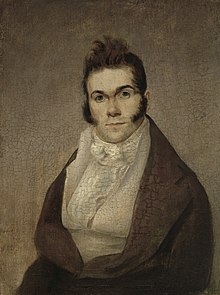Thomas Say
American naturalist From Wikipedia, the free encyclopedia
American naturalist From Wikipedia, the free encyclopedia
Thomas Say (June 27, 1787 – October 10, 1834) was an American entomologist, conchologist, and herpetologist. His studies of insects and shells, numerous contributions to scientific journals, and scientific expeditions to Florida, Georgia, the Rocky Mountains, Mexico, and elsewhere made him an internationally known naturalist. Say has been called the father of American descriptive entomology and American conchology. He served as librarian for the Academy of Natural Sciences of Philadelphia, curator at the American Philosophical Society (elected in 1817),[1] and professor of natural history at the University of Pennsylvania.[2][3]
Thomas Say | |
|---|---|
 Thomas Say by Joseph Wood, c. 1812 | |
| Born | June 27, 1787 |
| Died | October 10, 1834 (aged 47) |
| Nationality | American |
| Known for | "father of descriptive entomology in the United States" |
| Scientific career | |
| Fields | Natural history, Entomology |
| Institutions | Academy of Natural Sciences |
Born in Philadelphia into a prominent Quaker family, Thomas Say was the great-grandson of John Bartram, and the great-nephew of William Bartram. His father, Dr. Benjamin Say, was brother-in-law to another Bartram son, Moses Bartram. The Say family had a house, "The Cliffs" at Gray's Ferry, adjoining the Bartram family farms in Kingessing township, Philadelphia County. As a boy, Say often visited the family garden, Bartram's Garden, where he frequently took butterfly and beetle specimens to his great-uncle William.

Say trained to be an apothecary. A self-taught naturalist, Say helped found the Academy of Natural Sciences of Philadelphia (ANSP) in 1812. In 1816, he met Charles Alexandre Lesueur, a French naturalist, malacologist, and ichthyologist who soon became a member of the Academy and served as its curator until 1824.
At the Academy, Say began his work on what he would publish as American Entomology. To collect insects, he made numerous expeditions to frontier areas, risking American Indian attacks and hazards of traveling in wild countryside. In 1818, Say accompanied his friend William Maclure, then the ANSP president and father of American geology; Gerhard Troost, a geologist; and other members of the Academy on a geological expedition to the off-shore islands of Georgia and Florida, then a Spanish colony.
In 1819–20, Major Stephen Harriman Long led an exploration to the Rocky Mountains and the tributaries of the Missouri River, with Say as zoologist. Their official account of this expedition included the first descriptions of the coyote, swift fox, western kingbird, band-tailed pigeon, rock wren, Say's phoebe, lesser goldfinch, lark sparrow, lazuli bunting, orange-crowned warbler, checkered whiptail lizard, collared lizard, ground skink, western rat snake, and western ribbon snake.[4]

In 1823, Say served as chief zoologist in Long's expedition to the headwaters of the Mississippi River. He traveled on the "Boatload of Knowledge" to the New Harmony Settlement in Indiana (1826–34), a utopian society experiment founded by Robert Owen. Say was accompanied by Maclure, Lesueur, Troost, and Francis Neef, an innovative pedagogue. There he later met Constantine Samuel Rafinesque-Schmaltz, another naturalist.
On January 4, 1827, Say secretly married Lucy Way Sistare, whom he had met as one of the passengers to New Harmony, near the settlement. She was an artist and illustrator of specimens, as in the book American Conchology, and was elected as the first woman member of the Academy of Natural Sciences.
At New Harmony, Thomas Say carried on his monumental work describing insects and mollusks, leading to two classic works:
Many of the scientific names assigned by Say are no longer accepted. Lists of the former names matched with current scientific and common names are available.[5][6]
During their years in New Harmony, Say and Lesueur experienced considerable difficulties. Say was a modest and unassuming man, who lived frugally like a hermit. He abandoned commercial activities and devoted himself to his studies, making difficulties for his family.
Say died, apparently from typhoid fever, in New Harmony on 10 October 1834, when he was 47 years old.
Say described more than 1,000 new species of beetles, more than 400 species of insects of other orders, and seven well-known species of snakes.[7]
Other zoologists honored him by naming several taxa after him:[8]
Frederick Valentine Melsheimer, also considered the "Father of Entomology"
Seamless Wikipedia browsing. On steroids.
Every time you click a link to Wikipedia, Wiktionary or Wikiquote in your browser's search results, it will show the modern Wikiwand interface.
Wikiwand extension is a five stars, simple, with minimum permission required to keep your browsing private, safe and transparent.